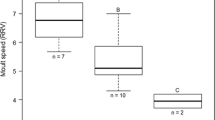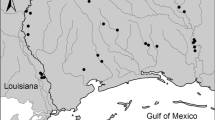Abstract.
High body mass caused by fat storage during migration is believed to increase a bird's risk of predation by decreasing its ability to escape predators. We demonstrate the negative effect of wing loading (mass/wing area) on escape speed and angle of two migrating species of shorebird. We also show significant differences in escape performance between the species and genders. To help explain these differences, we test two potential proximate causes, wing shape and leg bone length. Wing shape is correlated with differences in escape performance between the species, but we found no correlation of wing shape or leg bone length with gender. Ultimately, greater predation risk due to habitat use or larger body size, for the species and genders respectively, may have resulted in evolution of enhanced escape ability.
Similar content being viewed by others
Author information
Authors and Affiliations
Additional information
Electronic Publication
Rights and permissions
About this article
Cite this article
Burns, J.G., Ydenberg, R.C. The effects of wing loading and gender on the escape flights of least sandpipers (Calidris minutilla) and western sandpipers (Calidris mauri). Behav Ecol Sociobiol 52, 128–136 (2002). https://doi.org/10.1007/s00265-002-0494-y
Received:
Revised:
Accepted:
Issue Date:
DOI: https://doi.org/10.1007/s00265-002-0494-y




